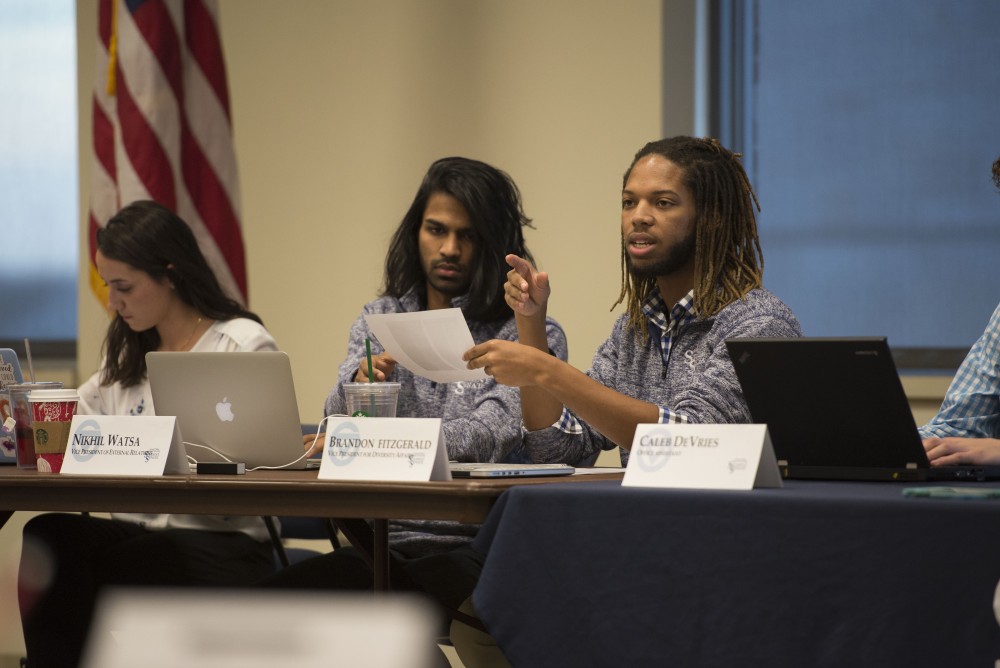Student senators, admissions office discuss recruitment, scholarships

GVL/Mackenzie Bush – Guest speaker, Jodi Chycinski, at the Student Senate meeting Thursday, Feb. 23, 2017.
Feb 27, 2017
Campus tours and student recruitment were the focal points of the Grand Valley State University student senate general assembly Thursday, Feb. 23, in the Pere Marquette Room.
Talking about students and their role in the GVSU community, Jodi Chycinski, GVSU’s director of admissions, spoke about the working relationship between the Admissions Office and student senate, which included the formation of an advisory group for recruiting incoming and transfer students.
“Having your insight really helps us do our jobs better because in fact you, our Grand Valley students, are our best recruiters,” Chycinski said. “There’s just no doubt about it.”
Discussing college visits and the student employees who give daily campus tours, Chycinski indicated that in the spring, the admissions office starts the recruitment process for fall 2018 by targeting current high school juniors.
Due to the volume of individuals touring GVSU’s campuses, two large group events are organized in March and April with about 800 to 1,000 individuals in attendance, Chycinski said, so having more student volunteers is necessary when meeting with prospective students.
“We train our tour guides, and we don’t train them what to say but really just how to handle a family and their route,” she said. “Having you volunteer as campus leaders just really makes us feel so much better because we know that when you step out, you are a great representative of the university.”
Chycinski said transfer students are also a significant target audience during the recruitment process.
There were more than 1,677 transfer students during the fall semester and 441 during the winter semester, she said, and the university is deliberate in its recruitment endeavors, demonstrating that GVSU contains one of the largest transfer populations in Michigan.
“The majority of Michigan community colleges are represented by students on our campus,” she said. “We have relationships with all the community colleges. The relationships vary depending on the number of students and how far away, so we are not in the U.P. all the time.”
Further data listed that 57 percent of the transfer students were female, 17 percent were from a minority group, 86 percent were full-time students and 45 percent were first-generation students.
“We value transfer students, and we hope they get the most out of their course work,” Chycinski said.
Brianna Pannell, a student senator on the diversity affairs committee, asked Chycinski about merit-based scholarships and test scores for incoming and transfer students.
Primarily, she asked if the Award of Excellence and the Presidential Scholarship were based on an individual’s grade-point average.
Chycinski said awarding transfer scholarships is based on the transfer student’s grade-point average. The Award of Excellence, she said, is presented to students who have completed 30 credits at the community college and have a 3.5 or higher grade-point average.
“It is based solely on their college and not their high school achievements,” Chycinski said.
River Gibbs, a student senator on the external relations committee and a transfer student from Grand Rapids Community College (GRCC), said he was pleased with the ease of the transfer process but questioned Chycinski about scholarships.
“The merit scholarships for freshmen versus transfers is (a) pretty extreme difference,” he said. “The Presidential Scholarship plus the Award for Excellence for freshmen is $10,000 a year, and we got the maximum, but its only $2,000 a year for transfer students. So, I’m kind of curious of why that discrepancy is there.”
In response, Chycinski said the Award for Excellence transfer scholarship is $2,000 and renewable for two years. The Award for Excellence for incoming freshmen students, she said, is $3,000 and renewable for four years of attendance.
The challenge, she said, is that competition is “fierce” between students in high school. With resources, it comes down to money available, she said.
“We have something very special here, and it is not uncommon for a student, whether it be a transfer or an incoming freshman student, to choose Grand Valley and to accept less money in terms of scholarship money to attend here,” she said. “We work really hard to make sure your experience is a positive one and that you’re getting what you should be for your tuition dollars.”





















